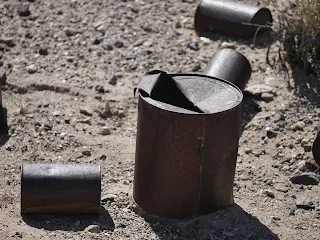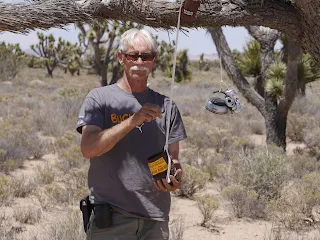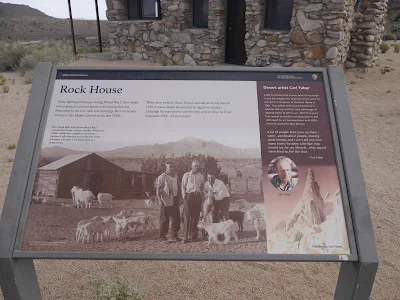As an explorer, the value of research can not be understated. One week prior to the trip J decided to one last 'Google' search.
 |
| Always update research - it's a must! |
Many thanks to the Mojave Desert Heritage and Cultural Association who put out the information concerning the closure of the road at mile 27. This is where the boys camped the first night. The closure, as mentioned in the last blog, was all of 3 1/2 miles but the National Park Service had a 29 mile alternate route. Yikes! Luckily the MDHCA had a simpler 14.2 mile detour which allowed saving of time and viewing some pretty cool stuff.
 |
| 14.2 vs 29 - a no brainer! |
 |
| Have your GPS and Guide Book handy - no wrong turns wanted |
After breaking camp Paul lit up the GPS, unfolded the map and directions supplied online by the MDHCA as the road beckoned.
Another item to remember when traveling the desert is how wonderfully beautiful it is with plant life. It is a green sea that spread ahead of us while driving the road - no miles of just dirt but an area full of life.
 |
| Paul recording the beauty of the Mojave Desert |
 |
| Cholla Cactus |
 |
| One type of Barrel Cactus |
 |
| Close up of blooms |
 |
| Forest of Joshua Trees |
Not to jump ahead but on the last night of the adventure Paul and John cooled off in Yermo laying about the pool at the KOA campground. A great way to end the trip - flushing toilets, showers, cold drinks, and other humans to talk to. The boys met a great traveling couple from Ohio - Lori and Joe Villanyi, who shared two photos they themselves shot of Bighorn Sheep - a rare find near Zzyzx Road.
 |
| Run for it boys and girls |
To actually get a photograph of these elusive and gorgeous animals may be a once in a lifetime shot. Well Joe and Lori got their chance and a nice job they did!
 |
| Oh, wait - time to get a drink of water and then run away |
At mile 8.3 of the detour, the Leiser Ray mine came into view just to the south. A once thriving mining consortium which pulled untold wealth from the grounds had now been long deserted but deserved a once over. The size of the mine was rather amazing considering its remoteness. No large graded roads leading in or out of the mine but just the desert trail we were following. The nearest town was Goffs, 8.6 miles southwest over sand, rocks, narrow paths, and just rough going. A good hour or more of travel time.
Observing a place like the Leiser Ray mine gave one a pause to ponder how rugged the individuals must have been in their pursuit of wealth. Tough, resourceful, and dreamers.
 |
| Not much remains but what does is huge |
 |
| Species of Ivy in an abandoned shaft |
 |
| Using a knife to open - how old are these cans? |
The day was wearing on and so was the heat. With open windows (no air since you don't want to over tax your vehicle in the heat) we traveled many miles but slowly. Everything moves slowly on the Mojave Road. One to view everything and secondly because that's how the road tells you to drive - real slow and careful.
By early afternoon, Lanfair Valley came into view and so did the 'penny can'. In the early 1980's someone decided to hang a can from a Joshua Tree and everyone who drove by was supposed to drop a penny into it - sort of a good luck thought we suppose.
Well - good luck always seems like the right thing to wish for.
 |
| The navigator needs luck |
 |
| So does the driver |
With all the luck a couple of pennies could afford, the dynamic duo hit the trail once again. Hour after hour of increasing heat and nerve wracking road brought the pair to Rock Springs. Of course, not until Dennis Casebier's statement (or understatement) came to fruition - "It is quite a steep hill" - describing the entrance to Watson Wash - no photographs were taken at this time since it was not steep in the normal sense but more like a ride from Disneyland.
The left side of the road did not match the right side of the road in height giving the FJ a thrill - if vehicles can get thrills. The driver wasn't thrilled standing on the brakes while the FJ continued on a downward motion toward the wash.
It's referred to as a 'white knuckler' by gripping the steering wheel so tightly as to cut off all blood flow to the fingers. J isn't a rock crawler and the FJ isn't designed as one but after grunting and huffing - J and not the FJ the wash was reached on a smooth drive to Rock Spring.
 |
| Camp Rock Spring looking east |
 |
| Easy loop around historic site with information |
Bert Smith was a WWI veteran who suffered serious health issues by being exposed to poisonous gas while fighting in the trenches in France. Upon returning to the United States he was told that he had a short time to live. Well, Bert didn't believe that nonsense and moved to Rock Spring where he and his family built quite a nice abode above Watson Wash and lived until 1967. Way to go - Bert!
 |
| The beginnings of the Rock House by Bert Smith |
 |
| Interior shot of the Rock House |
We read about all the water in the desert and the greenery we had encountered during the day certainly proved it but where was the proof? We found it not far from Rock Spring - plenty and it was bubbling up from the earth with the assistance of a windmill water pump. There was and still is plenty of water to take care of the needs of the desert and those willing and strong enough to survive the harsh conditions. Cattle are still raised out in the area and water troughs can be found here and there - especially at the elevation of Rock Spring which is nearly 4700 above sea level.
 |
| Windmill water pump equals . . . |
Where's there wind there may be water and water plentiful near Rock Spring. And what does that mean for the desert? Hmmm...
 |
| Water from the ground which equals . . . |
 |
| Trees and life - like this majestic hawk |
The Milky Way never looked as clear as it does when the nearest city lights are forty miles away or further. One of the benefits of traveling where most won't.
 |
| A perfect camp site |
 |
| Let your imagination go and what do you see? |
Thanks to Lori and Joe Villanyi for their photographs.
Please visit the Mojave Desert Heritage and Cultural Association for more information at - www.mdhca.org
Love this area. I had a friend who's wife lived in the area as a child. Her parents had come down from Oregon in the late 1800's and homesteaded. They had a windmill and an old block house. I have a lot of research materials that I have pulled about trusts, etc. Fascinating. I loved listening to his wife tell stories of growing up there. Raising corn broom and selling it to the army camps. Her brother was born there and died soon thereafter and is buried along a wash.
ReplyDeleteSteve - what you have seems fascinating and would love to look at it some day - John
ReplyDelete